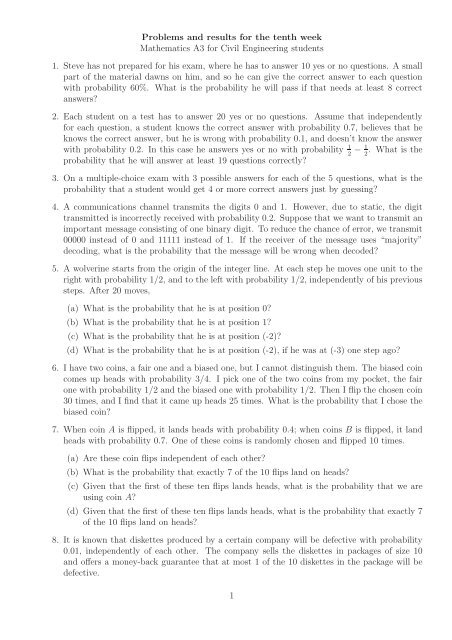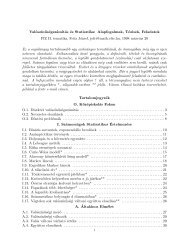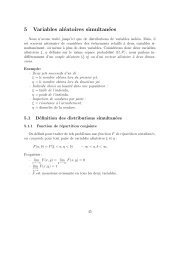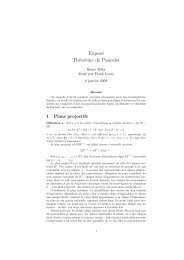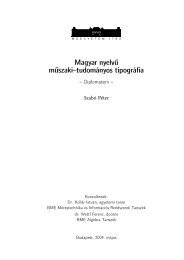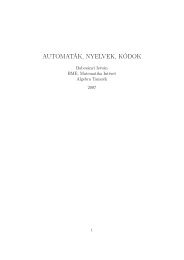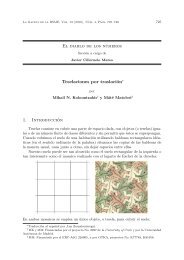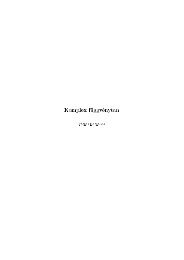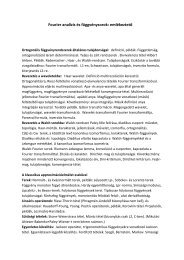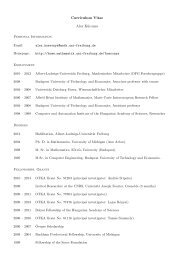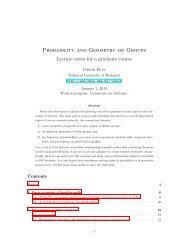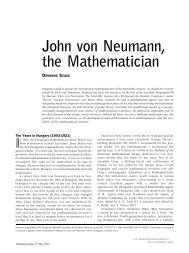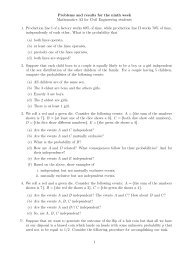problem set
problem set
problem set
Create successful ePaper yourself
Turn your PDF publications into a flip-book with our unique Google optimized e-Paper software.
Problems and results for the tenth week<br />
Mathematics A3 for Civil Engineering students<br />
1. Steve has not prepared for his exam, where he has to answer 10 yes or no questions. A small<br />
part of the material dawns on him, and so he can give the correct answer to each question<br />
with probability 60%. What is the probability he will pass if that needs at least 8 correct<br />
answers?<br />
2. Each student on a test has to answer 20 yes or no questions. Assume that independently<br />
for each question, a student knows the correct answer with probability 0.7, believes that he<br />
knows the correct answer, but he is wrong with probability 0.1, and doesn’t know the answer<br />
with probability 0.2. In this case he answers yes or no with probability 1 1 − . What is the<br />
2 2<br />
probability that he will answer at least 19 questions correctly?<br />
3. On a multiple-choice exam with 3 possible answers for each of the 5 questions, what is the<br />
probability that a student would get 4 or more correct answers just by guessing?<br />
4. A communications channel transmits the digits 0 and 1. However, due to static, the digit<br />
transmitted is incorrectly received with probability 0.2. Suppose that we want to transmit an<br />
important message consisting of one binary digit. To reduce the chance of error, we transmit<br />
00000 instead of 0 and 11111 instead of 1. If the receiver of the message uses “majority”<br />
decoding, what is the probability that the message will be wrong when decoded?<br />
5. A wolverine starts from the origin of the integer line. At each step he moves one unit to the<br />
right with probability 1/2, and to the left with probability 1/2, independently of his previous<br />
steps. After 20 moves,<br />
(a) What is the probability that he is at position 0?<br />
(b) What is the probability that he is at position 1?<br />
(c) What is the probability that he is at position (-2)?<br />
(d) What is the probability that he is at position (-2), if he was at (-3) one step ago?<br />
6. I have two coins, a fair one and a biased one, but I cannot distinguish them. The biased coin<br />
comes up heads with probability 3/4. I pick one of the two coins from my pocket, the fair<br />
one with probability 1/2 and the biased one with probability 1/2. Then I flip the chosen coin<br />
30 times, and I find that it came up heads 25 times. What is the probability that I chose the<br />
biased coin?<br />
7. When coin A is flipped, it lands heads with probability 0.4; when coins B is flipped, it land<br />
heads with probability 0.7. One of these coins is randomly chosen and flipped 10 times.<br />
(a) Are these coin flips independent of each other?<br />
(b) What is the probability that exactly 7 of the 10 flips land on heads?<br />
(c) Given that the first of these ten flips lands heads, what is the probability that we are<br />
using coin A?<br />
(d) Given that the first of these ten flips lands heads, what is the probability that exactly 7<br />
of the 10 flips land on heads?<br />
8. It is known that diskettes produced by a certain company will be defective with probability<br />
0.01, independently of each other. The company sells the diskettes in packages of size 10<br />
and offers a money-back guarantee that at most 1 of the 10 diskettes in the package will be<br />
defective.<br />
1
(a) What is the probability that a box contain more than one defective diskettes?<br />
(b) If someone buys 3 packages, what is the probability that he or she will return exactly 1<br />
of them?<br />
9. A newsboy purchases papers at HUF 100 and sells them at HUF 150. However, he is not<br />
allowed to return unsold papers. If his daily demand is a binomial random variable with<br />
n = 10 and p = 1/3, approximately how many papers should he purchase so as to maximize<br />
his expected profit?<br />
10. Approximately 80000 marriages took place in a country last year. Estimate the probability<br />
that for at least one of these couples<br />
(a) both partners were born on April 30;<br />
(b) both partners celebrate their birthday on the same day of the year.<br />
State your assumptions.<br />
11. There are 200 typos, randomly distributed, in a book of 400 pages. What is the probability<br />
that on page 13 there are more than one typos?<br />
12. How many chocolate chips should there be in a muffin on average if we want at least one<br />
chocolate chip in any given muffin with probability at least 0.99?<br />
13. The Run With Us Movement organized a foot-race at the Danube Bend. Unfortunately, the<br />
track passed through an area infected with ticks. After the race, 300 contestants found one<br />
tick, 75 found two ticks on their bodies. Based on this information, approximate the number<br />
of contestants in this race.<br />
14. Consider a roulette wheel consisting of 38 numbers – 1 through 36, 0, and double 0. If Smith<br />
always bets that the outcome will be one of the numbers 1 through 12, what is the probability<br />
that<br />
(a) Smith will loose his first 5 bets;<br />
(b) his first win will occur on his fourth bet?<br />
15. An urn contains 4 white and 4 black balls. We randomly choose 4 balls. If 2 of them are white<br />
and 2 are black, we stop. If not, we replace the balls in the urn and again randomly select 4<br />
balls. This continues until exactly 2 of the 4 chosen are white. What is the probability that<br />
we shall make exactly n selections?<br />
16. We repeatedly roll a die until we roll a 6. What is the expected number of times we roll that<br />
die? And if we roll two dice a time until we see a 6 on at least one of them?<br />
17. We repeatedly roll a die until we see the same number twice in a row. What is the expected<br />
number of rolls we make?<br />
18. Out of our 100 keys, only one opens the door in front of us. In the dark we don’t see the keys<br />
we already tried, and so we might pick and try any given key more than once. What is the<br />
probability that we open the door by at most 50 trials? And what if we put away the ones<br />
we already tried?<br />
2
19. If X is a geometric random variable, show analytically that<br />
(1) P{X = n + k | X > n} = P{X = k}.<br />
Give a verbal argument using the interpretation of a geometric random variable as to why<br />
the preceding equation is true.<br />
20. Mr. Bilk takes the tram to work each day, but he has no monthly pass nor ticket. Every day<br />
the ticket controller gets on the tram with probability 0.2, and then catches Mr. Bilk with<br />
probability 0.95. (Every day the ticket controller decides independently whether to get on<br />
Mr. Bilk’s tram or not.)<br />
(a) What is the probability that Mr. Bilk has a “lucky week” that is, he won’t get fined on<br />
the five working days of the week?<br />
(b) What is the probability that he will get fined exactly twice on the five working days of<br />
the week?<br />
(c) Given that Mr. Bilk had a lucky week, what is the probability that there was a ticket<br />
controller on his tram on each of the five working days?<br />
(d) What is the probability that he will get fined on Thursday the first time?<br />
21. The suicide rate in a certain country is 1 suicide per 100000 inhabitants per month.<br />
(a) Find the probability that in a city of 400000 inhabitants within this country, there will<br />
be 8 or more suicides in a given month.<br />
(b) What is the probability that there will be at least 2 months during the year that will<br />
have 8 or more suicides?<br />
(c) Counting the present month as month number 1, what is the probability that the first<br />
month to have 8 or more suicides will be month number i, i ≥ 1?<br />
3
1.00<br />
0.75<br />
0.50<br />
0.25<br />
0.00<br />
Answers<br />
1. Let X be the number of correct answers given. This is a binomial random variable with<br />
parameters n = 10, p = 0.6. The answer is<br />
P{X ≥ 8} = P{X = 8} + P{X = 9} + P{X = 10}<br />
<br />
10<br />
= · 0.6<br />
8<br />
8 · 0.4 2 <br />
10<br />
+ · 0.6<br />
9<br />
9 · 0.4 1 <br />
10<br />
+ · 0.6<br />
10<br />
10 · 0.4 0 ≃ 0.167.<br />
3. <br />
5<br />
·<br />
4<br />
<br />
1<br />
4 ·<br />
3<br />
<br />
2<br />
1 +<br />
3<br />
<br />
5<br />
·<br />
5<br />
<br />
1<br />
5 ·<br />
3<br />
<br />
2<br />
0 ≃ 0.045.<br />
3<br />
4. The information is wrongly decoded if at least three bits are incorrectly received. The probability<br />
of this is <br />
5<br />
· 0.2<br />
3<br />
3 · 0.8 2 <br />
5<br />
+ · 0.2<br />
4<br />
4 · 0.8 1 <br />
5<br />
+ · 0.2<br />
5<br />
5 · 0.8 0 ≃ 0.058.<br />
5.(a) The wolverine will be at 0 if and only if exactly 10 out of his 20 steps were left moves, and<br />
10 were right moves. The probability of this is 20 1 10 <br />
1 10<br />
· · ≃ 0.176.<br />
10 2 2<br />
(b) He can only be at even positions after an even number of steps, hence the answer is zero.<br />
(c) He will be at (-2) if and only if he made 11 steps to the left and 9 steps to the right. The<br />
probability of this is 20 1 11 <br />
1 9<br />
· · ≃ 0.160.<br />
11 2 2<br />
(d) Given that he is at (-3) before the last step, he will move one to the right, to (-2), with<br />
probability 1<br />
2 .<br />
6. Let X be the number of heads flipped, and {B} is the event that we use the biased coin. Then<br />
P{B | X = 25} =<br />
=<br />
P{X = 25 | B} · P{B}<br />
P{X = 25 | B} · P{B} + P{X = 25 | Bc } · P{Bc }<br />
30 3 25 <br />
1 5 1<br />
· · · 25 4 4 2<br />
30 3 25 <br />
1 5 1<br />
· · · 25 4 4 2 + 30 1 25 <br />
1 5 =<br />
1<br />
· · · 25 2 2 2<br />
325 325 ≃ 0.9987.<br />
+ 230 In general, having flipped heads n times (0 ≤ n ≤ 30) out of 30, the probability in question is<br />
P{B |X = n}<br />
P{B | X = n} =<br />
<br />
<br />
3 n<br />
3 n + 2 30.<br />
<br />
<br />
<br />
<br />
<br />
<br />
<br />
0 2 4 6 8 10 12 14 16 18 20 22 24 26 28 30<br />
4<br />
n
On the graph of this conditional probability we explore a sharp transition at around n = 19.<br />
7. Let X be the number of heads flipped, H the event that the first flip lands heads, A and B the<br />
events of picking the corresponding coins.<br />
(b)<br />
(c)<br />
P{A | H} = P{HA}<br />
P{H} =<br />
P{X = 7} = P{X = 7 | A} · P{A} + P{X = 7 | B} · P{B}<br />
<br />
10<br />
= · 0.4<br />
7<br />
7 · 0.6 3 · 1<br />
2 +<br />
<br />
10<br />
· 0.7<br />
7<br />
7 · 0.3 3 · 1<br />
≃ 0.155.<br />
2<br />
P{H | A} · P{A}<br />
P{H | A} · P{A} + P{H | B} · P{B} =<br />
0.4 · 1<br />
2<br />
0.4 · 1<br />
2<br />
+ 0.7 · 1<br />
2<br />
= 4<br />
11<br />
≃ 0.364.<br />
(a) Flipping heads first will make it likely that we are using coin B, which in turn will increase<br />
the chances for flipping heads the second time. Hence the flips are not independent. Let’s<br />
see a computation for this:<br />
From the denominator of the previous display, we have P{H} = 0.55 that is, any given flip<br />
will land heads with probability 55%. However, we already know that the first flip landing<br />
heads will modify the probabilities of our coins in accordance with part (c): P{A | H} =<br />
4/11, P{B | H} = 7/11. Hence the probability that the second flip comes heads (let us<br />
denote this event by H2), given that the first flip landed heads, is<br />
P{H2 | H} = P{H2 | A} · P{A | H} + P{H2 | B} · P{B | H} = 0.4 · 4 7 13<br />
+ 0.7 · =<br />
11 11 22<br />
≃ 0.591.<br />
Therefore, the first flip landing on heads modified the probability of the second flip coming<br />
up heads from 0.55 to 0.591; the flips are not independent.<br />
Rather than independence, we have the so-called conditional independence property here:<br />
given that we use coin A, flips are independent. Similarly, given that we use coin B, flips are<br />
independent. Without those conditions, however, we do not have independence.<br />
(d) If we already know that the first flip lands heads, that will modify the probabilities of our<br />
coins in accordance with part (c): P{A | H} = 4/11, P{B | H} = 7/11. After the first flip we<br />
have 9 more flips to make, out of which we want Y = 6 to be heads. The probability of this<br />
is<br />
P{Y = 6} = P{Y = 6 | A} · P{A | H} + P{Y = 6 | B} · P{B | H}<br />
<br />
9<br />
= · 0.4<br />
6<br />
6 · 0.6 3 · 4<br />
11 +<br />
<br />
9<br />
· 0.7<br />
6<br />
6 · 0.3 3 · 7<br />
≃ 0.197.<br />
11<br />
8.(a) Let X be the number of defective diskettes in a package. Then X is a binomial random<br />
variable with parameters n = 10 and p = 0.01. The package can be returned if X > 1. The<br />
probability of this is<br />
<br />
10<br />
P{X > 1} = 1−P{X = 0}−P{X = 1} = 1− ·0.01<br />
0<br />
0 ·0.99 10 <br />
10<br />
− ·0.01<br />
1<br />
1 ·0.99 9 ≃ 0.00427.<br />
(b) Packages can be returned independently of each other with the above probability. Hence the<br />
answer is <br />
3<br />
· 0.00427<br />
1<br />
1 · [1 − 0.00427] 2 ≃ 0.0127.<br />
5
9. Let us denote the number of purchased papers by m, the number of papers sold by X, and the<br />
demand by Y . Then<br />
<br />
Y, if Y < m,<br />
X =<br />
m, if Y ≥ m.<br />
Since Y is binomial with parameters n = 10 and p = 1/3, X will have mass function<br />
⎧ <br />
10<br />
<br />
1<br />
i <br />
2<br />
10−i ⎪⎨<br />
P{Y = i} = · ·<br />
, if i < m,<br />
i 3 3<br />
p(i) = P{X = i} =<br />
10<br />
<br />
10<br />
<br />
1<br />
j <br />
2<br />
10−j ⎪⎩<br />
P{Y ≥ m} = · · , if i = m.<br />
j 3 3<br />
j=m<br />
The cost of buying papers is 100 · m forints, the revenue is 150 · X forints, and so the newsboy’s<br />
expected profit is<br />
N = E(150 · X − 100 · m) = 150 · E(X) − 100 · m.<br />
To determine E(X), we use the above mass function:<br />
m m−1 <br />
E(X) = i · p(i) = i ·<br />
i=0<br />
i=0<br />
<br />
10<br />
·<br />
i<br />
<br />
1<br />
i ·<br />
3<br />
<br />
2<br />
10−i + m ·<br />
3<br />
10<br />
j=m<br />
<br />
10<br />
·<br />
j<br />
<br />
1<br />
j ·<br />
3<br />
<br />
2<br />
10−j .<br />
3<br />
For each given m, this formula gives a concrete number, which can be plugged in the display above<br />
to compute the expected profit (with a calculator or a computer algebra system). Results are:<br />
m 0 1 2 3 4 5 6 7 8 9 10<br />
N 0 47.4 81.79 86.92 53.03 -15 -103.52 -200.57 -300.06 -400 -500<br />
The greatest expected profit is realized when 3 papers are bought.<br />
10. We assume that spouses were independently born with equal chance on any day of the year<br />
(we do not deal with leap years).<br />
(a) The probability that both partners of a given couple were born on April 30 is p = 1/3652 ≃<br />
7.51 · 10−6 . The number X of such couples is binomial with parameters n = 80 000 and the<br />
above p. The probability in question is<br />
<br />
80 000<br />
P{X ≥ 1} = 1 − P{X = 0} = 1 − ·<br />
0<br />
<br />
1<br />
3652 0 <br />
· 1 − 1<br />
3652 80 000<br />
≃ 0.451.<br />
Our formulas simplify a lot after realizing that the data given place the <strong>problem</strong> in the <strong>set</strong>ting<br />
of the Poisson approximation: n is large, p is small, and their product is λ = np =<br />
80 000/365 2 ≃ 0.6. Hence the distribution of X can be approximated by a Poisson distribution:<br />
P{X ≥ 1} = 1 − P{X = 0} ≃ 1 − e −0.6 ≃ 0.451,<br />
which agrees to at least three digits with the above binomial probability.<br />
(b) The probability that partners of a given couple have the same birthday is 1/365. The number<br />
Y of such couples is now binomial with parameters n = 80 000 and p = 1/365. It is still true<br />
that n >> λ = np, hence the Poisson approximation is still valid. The above probabilities in<br />
this case are:<br />
<br />
80 000<br />
<br />
1<br />
0 <br />
P{Y ≥ 1} = 1 − P{Y = 0} = 1 − · · 1 −<br />
0 365<br />
1<br />
80 000<br />
≃ 1 − 4.8 · 10<br />
365<br />
−96 ,<br />
6
that is practically = 1. With the Poisson approximation λ = np = 80 000/365 ≃ 219.2, and<br />
that is practically = 1.<br />
P{Y ≥ 1} = 1 − P{Y = 0} = 1 − e −219.2 ≃ 1 − 6.49 · 10 −96 ,<br />
13. The number X of ticks found in a contestant is Poisson distributed, with an unknown λ<br />
parameter. Assuming that n contestants were racing, we approximate P{X = 1} ≃ 300/n and<br />
P{X = 2} ≃ 75/n based on the data given. With the Poisson mass function, we now have to solve<br />
the system of equations<br />
λ1 1! · e−λ ≃ 300<br />
n<br />
λ2 2! · e−λ ≃ 75<br />
n .<br />
Dividing the second equation by the first one we have λ/2 ≃ 1/4, that is λ ≃ 1/2. Hence by the<br />
first equation n ≃ 300 · eλ /λ ≃ 989.<br />
14. Smith will win each of his bets with probability p = 12/38 = 6/19. Hence<br />
(a) (1 − p) 5 = <br />
13 5,<br />
19<br />
(b) (1 − p) 3 · p = <br />
13 3 6 · 19 19 .<br />
15. The probability of drawing exactly two white balls at a given draw is p = 4 4 8 18<br />
· / = 2 2 4 35 .<br />
The probability that we make n draws is, according to the geometric distribution, (1 − p) n−1 · p =<br />
17 n−1 · 18/35 n .<br />
16. Rolling one die, the number of rolls we make is geometric with parameter p = 1/6. The<br />
expected number of rolls is 1/p = 6.<br />
Rolling two dice, we see at least one 6 if and only if we do not roll something else on both dice,<br />
that is, with probability p = 1 − <br />
5 2<br />
= 11/36. The number of rolls is now geometric with this<br />
6<br />
parameter, the expectation is now 1/p = 36/11.<br />
17. Except for the first roll, each time independently we roll the same as the previous time with<br />
probability 1/6. Hence the number of rolls we make after the first one is geometric with parameter<br />
p = 1/6, and with expectation 6. Together with the first roll, we are expected to roll 7 times.<br />
18. We assume that keys are tried independently and by giving equal chance to each key. Then<br />
each time we will succeed with probability 1/100. The first 50 trials will all fail, if 50 times we have<br />
a wrong key in our hands. The probability of this is <br />
99 50,<br />
and the answer is the probability of<br />
100<br />
the complement event, 1 − <br />
99 50<br />
≃ 0.395.<br />
100<br />
If we put away the keys we already tried, then we open the door by at most 50 trials if the right<br />
key was among the first 50 in the random order in which we tried the keys. Since the right key can<br />
be at any position of that order with equal chance, the probability is now 50/100 = 0.5.<br />
19. The <strong>problem</strong> clearly asks for k > 0, as in other cases both sides of the equality are zero. For<br />
k > 0<br />
P{X = n + k and X > n}<br />
P{X = n + k | X > n} = =<br />
P{X > n}<br />
P{X = n + k}<br />
P{X > n}<br />
= (1 − p)n+k−1 · p<br />
(1 − p) n<br />
= (1 − p) k−1 · p = P{X = k}.<br />
Here we used the geometric mass function, and the fact that P{X > n}, the probability that the<br />
first n trials all fail, is (1 − p) n .<br />
7
The verbal argument can be the following: assume that none of the first n experiments succeeded.<br />
This is precisely the condition on the left hand-side. On the left we see the conditional probability,<br />
under this condition, that the first experiment to succeed, counted from the n + 1st trial, will be<br />
the kth one. By independence, the condition does not matter, and the conditional probability will<br />
agree with the unconditional probability of seeing the first success at the kth trial if we just restart<br />
the experiments. This is the probability we see on the right hand-side.<br />
Equation (1) expresses the memoryless property of the geometric distribution: the condition that<br />
time for success has not come yet will not give any information about the number of further<br />
experiments needed in order to see the first success. This random number is the same as if the<br />
experiments would have been restarted.<br />
20. Mr. Bilk will be fined independently with probability p = 0.2 · 0.95 = 0.19. In the five days the<br />
number of fines will be binomial with the above parameter p and n = 5. Hence<br />
(a) P{X = 0} = 5 0 5 · 0.19 · 0.81 ≃ 0.349.<br />
0<br />
(b) P{X = 2} = 5 2 3 · 0.19 · 0.81 ≃ 0.192.<br />
2<br />
(c) Let E be the event that on each of the five days the ticket controller was on the tram, and F<br />
the event that Mr. Bilk had a lucky week. Then P{EF } = P{F | E} · P{E} is the probability<br />
that on each day tickets were inspected, but Mr. Bilk escaped fines all five times. P{F } has<br />
already been computed in part (a):<br />
P{E | F } =<br />
P{F | E} · P{E}<br />
P{F }<br />
≃ 0.055 · 0.2 5<br />
0.349 ≃ 2.87 · 10−10 .<br />
(d) On the first three days Mr. Bilk was not fined, and on the fourth day he finally got fined.<br />
The probability of this is (1 − p) 3 · p = 0.81 3 · 0.19 ≃ 0.101.<br />
21. We assume that inhabitants will commit suicide independently, with the same chance in each<br />
period of the year.<br />
(a) In the city of 400000 habitants we expect 4 suicides per month, hence the number X of<br />
suicides is Poisson distributed with parameter λ = 4.<br />
p : = P{X ≥ 8} = 1 −<br />
7<br />
P{X = j} = 1 −<br />
j=0<br />
7<br />
j=0<br />
4 j<br />
j! · e−4 ≃ 0.0511.<br />
(b) The number Y of such months of the year is binomial with the above p and n = 12 parameters.<br />
P{Y ≥ 2} = 1 − P{Y = 0} − P{Y = 1}<br />
<br />
12<br />
= 1 − · 0.0511<br />
0<br />
0 · (1 − 0.0511) 12 −<br />
<br />
12<br />
· 0.0511<br />
1<br />
1 · (1 − 0.0511) 11 ≃ 0.123.<br />
(c) The number Z of the first such month is a geometric random variable with the above parameter<br />
p.<br />
P{Z = i} = (1 − p) i−1 · p = (1 − 0.0511) i−1 · 0.0511.<br />
8


